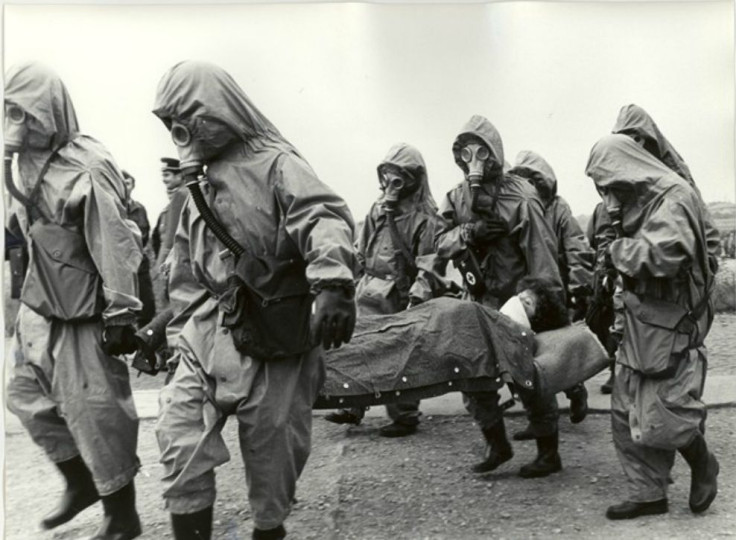Are Infectious Disease Outbreak Films Scientifically Accurate? The Truth About Hollywood's Depiction Of World Destruction

Dead bodies strewn throughout the streets, cities engulfed in widespread hysteria. Disease is spreading, and humans, for perhaps the first time, begin to realize they were just placed on the endangered species list. Scenes like this can be found in most films that depict an infectious disease outbreak. Viewers love them because they represent a glamorous yet unsettling depiction of events that could probably happen. But it’s important to remember that part of what makes Hollywood so enthralling is its tendency to side-step accuracy in order to “up” the shock factor. When it comes to something as realistic as a deadly disease, it's important to discern where filmmakers get it right, and where they’ve employed poetic license.
Some outbreak films, such as Contagion and Outbreak, present realistic pathogens that spread fast and kill even faster. Other films, such as Quarantine and I Am Legend, introduce a more fantasy-based virus that spreads just as fast, but rather than killing its victims, turns them into bloodthirsty monsters. Regardless of the virus’s pathology, most outbreaks in these films begin in the same way: A world map quickly becomes covered in crisscrossing lines, as cases of the disease pop up in every world capital.
Viruses on a Plane
In truth, we live in a jet setting age, and flight paths connect to just about every corner of the Earth on a daily basis. That said, is an airplane a major driver of disease transmission?
When it comes to being trapped in a dangerous place with nowhere to run, an airplane can be our worst nightmare. In FX’s The Strain, a strange virus sweeps through an airplane midflight, killing nearly everyone on the plane and bringing a contagious and deadly virus to the center of densely populated New York City. 1996’s 12 Monkeys and 2013’s World War Z have similar scenes, and in real-life, passengers might question their safety, expressing skepticism about the airplane’s ventilation system. However, according to a 2007 study, there is no legitimate scientific data linking cabin ventilation systems to heightened health risks when compared to other modes of transportation, such as cars or even office buildings.
About 50 percent of the air on a standard commercial flight is taken from outside the plane, where it is heated by the engine before being pumped into the cabin. The other half is recirculated after passing through high-efficiency particulate air filters (HEPA). This filtration system is no joke. According to the study, it’s 99.97 percent effective at removing dust, vapors, bacteria, and fungi. It can even eliminate airborne viruses by capturing the tiny droplets the viruses use to travel from host to host. Chances are, if you’re on the same plane as someone who is contagious with an airborne disease, you have a small chance of becoming infected yourself.

The Outbreak Begins
In another scenario, from the moment Patient Zero — the first person to become infected with a virus — arrives at their destination (the setting of the film), the virus within them proceeds to wipe out nearby populations at a terrifying rate. However, in reality, the speed with which diseases spread is largely dependent on the pathogen’s method of transmission.
The most difficult outbreaks to control are those caused by airborne pathogens that spread through the air in tiny droplets. Realistically, many of the deadliest diseases in human history are not airborne, meaning that merely being in the vicinity of a sick person poses no danger. Let’s take Ebola, for instance, one of the planet’s terrifying ailments. In early 2014 an Ebola outbreak began in West Africa, and according to the Centers for Disease Control and Prevention, over 11,000 individuals have died since. The outbreak still isn’t over, but despite a high death toll, Ebola isn’t actually as contagious as you might think. In order to become infected with Ebola, an individual has to make direct contact with bodily fluids from a sick person who is actively displaying symptoms. HIV, another widespread disease responsible for the death of millions, also requires the direct exchange of bodily fluids in order to infect a new host. As a result, these diseases are much easier to contain and epidemics are less likely to turn into pandemics.
Of course, some diseases are more infectious than others. For example, nine out of 10 unvaccinated individuals exposed to the airborne measles virus will become infected. Still, our ability to identify, quarantine, and treat measles patients, along with the development of the measles vaccines, means that most measles outbreaks are short-lived and quickly dealt with.
Zombies Aren’t Real
In many outbreak films, an infected individual becomes even more dangerous when they die, whether it’s because they turn into a bloodthirsty zombie or their contagious body is unknowingly exposed to an entire hospital. Here’s where Hollywood gets it right (sort of). Although, to date, there are no diseases that turn the dead into the slightly undead, cadavers of those who passed away from an infectious disease are still not something to mess around with. For the most part, pathogens cannot survive on dead bodies; however, scientists discovered that the Ebola virus can remain contagious for an unknown amount of time on these bodies, Smithsonian reported. Unfortunately, because of this, researchers found that handling the dead bodies of other victims was one of the most common methods of viral transmission during last year’s outbreak.
Patient Zero
The plot of many disaster films involves tracking down Patient Zero. In 12 Monkeys, nearly all 131 minutes of the movie involves Bruce Willis in a race against time to uncover the origins of a devastating apocalyptic plague. In reality, Patient Zero is important for controlling the outbreak. These individuals give doctors clues to how and when outbreaks start, and also help them understand how the virus spreads or whether it’s mutated. Tracking down the first Ebola victims, for example, helped to confirm the idea that the virus’s transmission occurred from handling the dead bodies, Live Science reported. This finding then helped to prevent countless new cases of the disease. However, unlike how it’s depicted in Outbreak, finding Patient Zero is not exactly an action-filled adventure. Rather, it’s often a tedious process.
“We call it shoe-leather epidemiology. Health care workers go out in the field and wear holes in their shoes, figuratively speaking, going from case to case,” Dr. William Schaffner, a professor of preventive medicine and infectious diseases at Vanderbilt University Center in Nashville, Tenn., told LiveScience, helping to illustrate the painstaking nature of the work.
Along with Patient Zero, another popular theme in outbreak movies is a lone person who possesses a unique immunity to the deadly effects of the virus and is therefore key to saving humanity (think 28 Days Later and World War Z ). In reality, this is a popular tactic used by researchers and drug developers. For example, some of the most promising HIV functional cures and vaccines are those that mirror the genetic makeup of those who remain unaffected by the disease due to a fortuitous mutation. However, what Hollywood movies get wrong is timing. Cures and vaccines take decades of research to develop and are almost never created in the midst of outbreak hysteria.
Sick People Don’t Always Die
In outbreak movies, becoming infected with a disease is nearly an automatic death sentence.The few that make a miraculous recovery hold the “key” to saving the rest of humanity. In reality, even the deadliest diseases don’t have mortality rates as high as those in the movies. The World Health Organization puts the Ebola’s mortality rate at around 50 percent, a number that can vary considerably between outbreaks but still illustrates that there’s hope for recovery. H1N1, also known as the swine flu may have made headlines during the 2009 pandemic, but Reuters reported that the death rate from the disease was only around 0.02 percent. Hollywood likes to leave out the fact that our bodies’ immune systems are relatively capable of fighting off most infections and diseases. Add medicine and modern health care into the equation and you’re even less likely to die from a pathogen or virus.
Toward the end of the Ebola outbreak in West Africa, Bill Gates predicted that, in the future, widespread epidemics, “far worse than Ebola,” would lead to the deaths of millions. Although, epidemics are a sad but true part of human history, they rarely turn into pandemics, which affect every part of the world. And even when they do turn into pandemics, like HIV/AIDS did, they still don’t infect everyone. In the Pacific island of Samoa, only HIV has only ever been recorded 23 times, according to UNAids — the island’s population is 190,000.
Disease and the collapsing of civilizations often go hand-in-hand, but many real-life examples of actual epidemics have shown that humanity fares much better than Hollywood gives it credit for. During the 14th century, the Black Death, one of the deadliest pandemics in history, caused by the plague, wiped out as much as half of Europe’s population in only four years. The Spanish flu, meanwhile, killed up to 25 million people in its first 25 weeks. Although these historic events were filled with panic and hysteria, life went on, and it’s likely to continue moving forward regardless of any future events.
Published by Medicaldaily.com



























